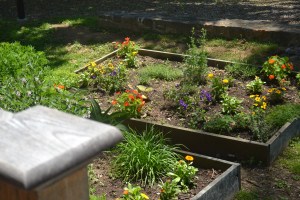As many of our visitors can attest to, there is a beautiful and thriving garden in front of our Barns-Brinton House (which, by the way, will be celebrating its 300th birthday this Saturday!). The garden was first started by the Spade and Trowel Garden Club of Kennet Square in 1981 and has been cared for ever since by our volunteer Garden Club. Back when the house was first built and occupied, the gardens would’ve been behind the house. However, since Route 1 relocated there in the 20th century, we’ve had to
 have our gardens in front of the structure.
have our gardens in front of the structure.
Trying to still be as authentic as possible, despite the relocation, the garden has mostly herbs and vegetables. Herbs were grown during colonial times and used for a myriad of reasons, such as cooking, dyeing, and making medicines. Of course, the uses differ with each herb.
One of the many herbs that we grow is the calendula, also known as the marigold. It blooms throughout the summer, so it will be keeping our summer visitors plenty of company. Their flowers have skinny petals and are a yellow-orange color. First introduced in England in 1573, they began to appear in what we know call the United States, in 1642. When used for dye, they produce yellow or brown, depending on the type of mordant.
Another herb is the spearmint. It produces small, light purple or white flowers throughout the entirety of the summer down from the top of the stem. It has no stalks, differentiating it from peppermint, which has short-stalked leaves. The spearmint is widely accepted to be a native plant of England, though some wonder if it had been imported by the Romans eons ago. However, we do know that it was found in Plymouth, Massachusetts, one of the earliest colonies in the Americas. Because of its fresh scent, it is often added to teas. Nowadays, we might even find it in soaps.
Of course, we grow many other kinds of herbs. The oil of lavender, or lavandula, was used for medicinal purposes, especially during World War I. Bloodroot is a native to the United States, and was used by Native Americans for medicinal reasons as well.
In the Barns Brinton House, the family parlor is situated right next to the public tavern room on the first floor. We imagine Elizabeth Barns there with her daughter, also named Elizabeth, putting the herbs from their gardens to good use by the fireplace.
Information comes from Raymond L. Taylor’s “Plants of Colonial Days” and the Brooklyn Botanic Garden Record Plants & Gardens’ “Dye Plants and Dyeing”.
